Wreath-making workshops
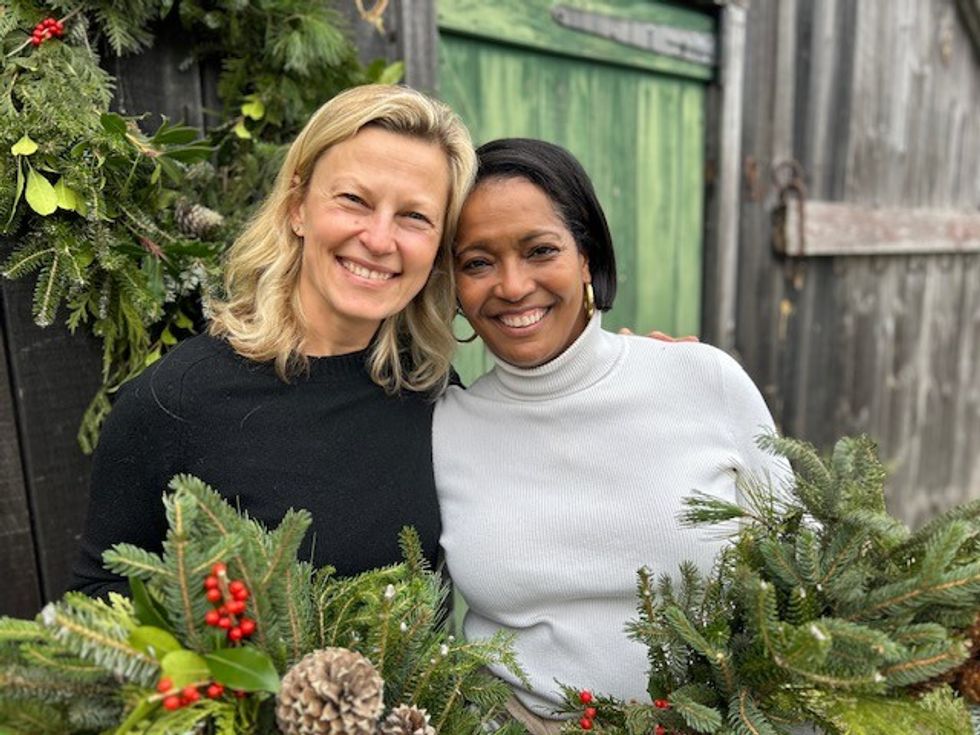
Barbara Ellis and U.S. Rep. Jahana Hayes (D-5) made wreaths at Great Mountain Forest on Dec. 2.
Photo by Jennifer Almquist

Woodsmoke curling above the small, weathered barn and, within the faded green doors, the smell of fresh-cut pines and cider warming on the woodstove made a perfect setting for the annual wreath-making workshops at Great Mountain Forest (GMF) in Falls Village.
For decades, folks have enjoyed creating their seasonal masterpieces using evergreens, berries, and pine cones gathered from the woods nearby.
On Saturday, Dec. 2, the first pair of workshops took place at the Mountain House Barn on Canaan Mountain Road under the expert guidance of GMF staff: director of programs and operations Matt Gallagher and office manager Vicki Muni Nelson. [The second set of workshops took place Saturday, Dec. 9.]
Participants in the wreath-making ranged from two women who learned about the workshops from a friend they met at Yellowstone to a local family with two young daughters, and to everyone’s delight, U.S. Rep. Jahana Hayes (D-5) and Barbara Ellis, her friend and campaign manager at Friends of Jahana Hayes, arrived ready to join the fun.
Gallagher welcomed the 20 or so wreath makers and explained the names and origins of the various pine branches lying on the rough floor in great piles. A blaze of red winterberries in a large bucket stood next to baskets filled with pine cones gathered from various types of conifers that grow in the GMF. There were large bows of various ribbons: red, shiny gold, brocades, patterns of vintage trucks, burgundy velvet, and even some reindeer images. The staff had made educational signs with the specific names of the conifers and cones, listed with their Latin names.
Muni Nelson demonstrated the methods of wreath making, which involved metal rings, spools of green garland wire, wire cutters, hot glue guns for adhering the cones, and wired stakes for the bows. A patient teacher, Muni Nelson worked with each maker during the session. A father and mother said they were making some good family memories. After some guidance, the two girls set right to work making their own wreaths that they held up proudly at the end.
Hayes said she was happy to spend time with her friend and, yes, have some personal time, which is in short supply. After another difficult vote in Congress the day before, Hayes felt respite in the barn working with her hands. She laughed as she twisted her greens with wire and created a festive bow: “You must know that I am very competitive, even with crafts!” Later, she wrote on her social media page: “I have found another CT-05 gem! Had a fabulous afternoon at Great Mountain Forest holiday wreath making workshop. Craft, laughs, and hot apple cider-a great way to get into the holiday spirit!”
Norfolk artist Bevin Ramsey came with his petite mother, Maureen, who had traveled from Ottawa to spend time with her family and celebrate a granddaughter’s birthday. The joy between them was contagious.
Each worktable was a flurry of activity. Ellen Walsh of Winchester Center showed off her steel-toed work boots as she tackled her huge wreath.
Journalist Avice Meehan chatted with Hayes, both having recently attended former Gov. Weicker’s memorial service. Meehan had been his press secretary. Susannah Wood from Norfolk worked solo, while Norfolk tax collector Sarah Bruso shared her table with Martha Mullins.
According to The New York Times in a Dec. 25, 1988, article: “Ancient Pagan people, endowing trees with spirit, sheltered the branches of life-preserving evergreens through the frozen winter. Early Romans gave gifts of green branches at New Year’s, bestowing the wish for health and vigor upon family and friends. The evergreen wreath its circular shape an emblem of perfection, unity, and the enduring sun-later became a symbol for Christ’s suffering. Evergreens embody eternal life. . . today’s wreaths communicate a sense of joy and a desire for peace.”
As they joined in spirit with an ancient, symbolic and traditional craft, the Norfolk makers proudly hung their wreaths on the gray barn walls for the group to admire. One by one, the jolly revelers walked away through the surrounding meadow bearing their festive wreaths home to grace their doors and windows.
The following information was provided by the Connecticut State Police at Troop B. All suspects are considered innocent until proven guilty in a court of law.
Warrant arrest
On the evening of Dec. 12, troopers arrested Douglas Palmer, 34, of Colebrook on an active arrest warrant relating to an incident that occurred on March 7 on Twin Lakes Road in Salisbury. He was arrested on two counts: “offer to make or make any home improvement without having a current certificate of registration,” and “failure to refund the amount paid for a home improvement within 10 days of a written request.” Palmer was released on a $1,500 non-surety bond and is scheduled to appear at Torrington Superior Court on Dec. 19.
Disturbance yields arrest
On Dec. 13, troopers were dispatched to Locust Avenue in Salisbury on the report of an active disturbance. While investigating, troopers discovered that Tina Humes, 48, of Salisbury had an active warrant out for her arrest for violating probation. Humes was held on a $15,000 cash bond and was transported to Torrington Superior Court for her arraignment on Dec. 15.
Collision with parked vehicle
On the afternoon of Dec. 14, Jeremy Glass, 32, of Suffield, Connecticut was parked on the eastbound shoulder of Cornwall Bridge Road near the intersection with Herrick Road. Michael Fass, 44, of New York City, was traveling east on Cornwall Bridge Road and collided with the rear of delivery Ford Transit T-350 that Glass drove in his leased Hyundai Ioniq 5. All parties were evaluated by Sharon EMS but were found to have no apparent injury. Fass was issued an infraction for distracted driving other than the use of a mobile phone.
Snowy slide-out
Early in the morning on Dec. 14, Nelfy Veizaga Montano was traveling west on Johnson Road in Falls Village on snowy roads when she slid off the roadway while negotiating a downhill curve. She was uninjured in the incident, but her Honda CRV was disabled. She was ultimately issued a written warning for traveling too fast for conditions.
Downtown Lakeville accident
On the afternoon of Dec. 14, Alison Holmes, 25, of Lakeville was driving east on Main Street in Lakeville near the intersection with Bostwick Street when she veered off the road, striking a Department of Transportation-owned bridge. The Subaru Outback she was driving was disabled in the accident, but Holmes reported no injuries. She was issued an infraction for failure to maintain lane.
Car vs. utility pole
Early in the morning on Dec. 15, Enrique Hairol Ramirez Pula, 48, of West Springfield, Massachusetts was driving south on Route 7 near the intersection with Undermountain Road in Falls Village. While attempting to navigate a downhill curve, he drifted across the center line and attempted to recover, subsequently overcorrecting and veering off the roadway, ultimately striking a utility pole. The vehicle was disabled but he was uninjured in the accident, for which he was issued a written warning for failure to maintain lane.
The Lakeville Journal will publish the outcome of police charges. Send mail to P.O. Box 1688, Lakeville, CT 06039, Attn: Police Blotter, or email editor@lakevillejournal.com
Cellist Christopher Hoffman wrote and recorded his 13-track, solo record ‘Rex’ while living in the former home of Rex Brasher in Amenia, the self-taught painter who created 1,200+ watercolors of North American birds.
When cellist, composer and filmmaker Christopher Hoffman moved into the former home of Rex Brasher in Amenia in August 2023, he didn’t arrive with a plan to make an album about the painter and ornithologist who once lived there. But once he began to learn about the home’s former inhabitant — about his attention to land, to birds, to work done slowly and with devotion — he started to compose. “Rex,” Hoffman’s solo cello album (releases Jan. 16, 2026) is not a portrait of Brasher so much as an echo of a person, a place and a way of seeing the world.
Brasher (pronounced “brazier”) was born in Brooklyn in 1869, the son of a stockbroker whose passion for birds left a lifelong mark. After his father’s death, Brasher vowed to paint every bird in North America, and to do it from life. He eventually created more than 1,200 works, depicting birds with a precision and intimacy that bordered on obsession. Working largely outside the art world, Brasher lived on 116 wooded acres he called Chickadee Valley, where he painted, wrote and published his monumental 12-volume “Birds and Trees of North America.”
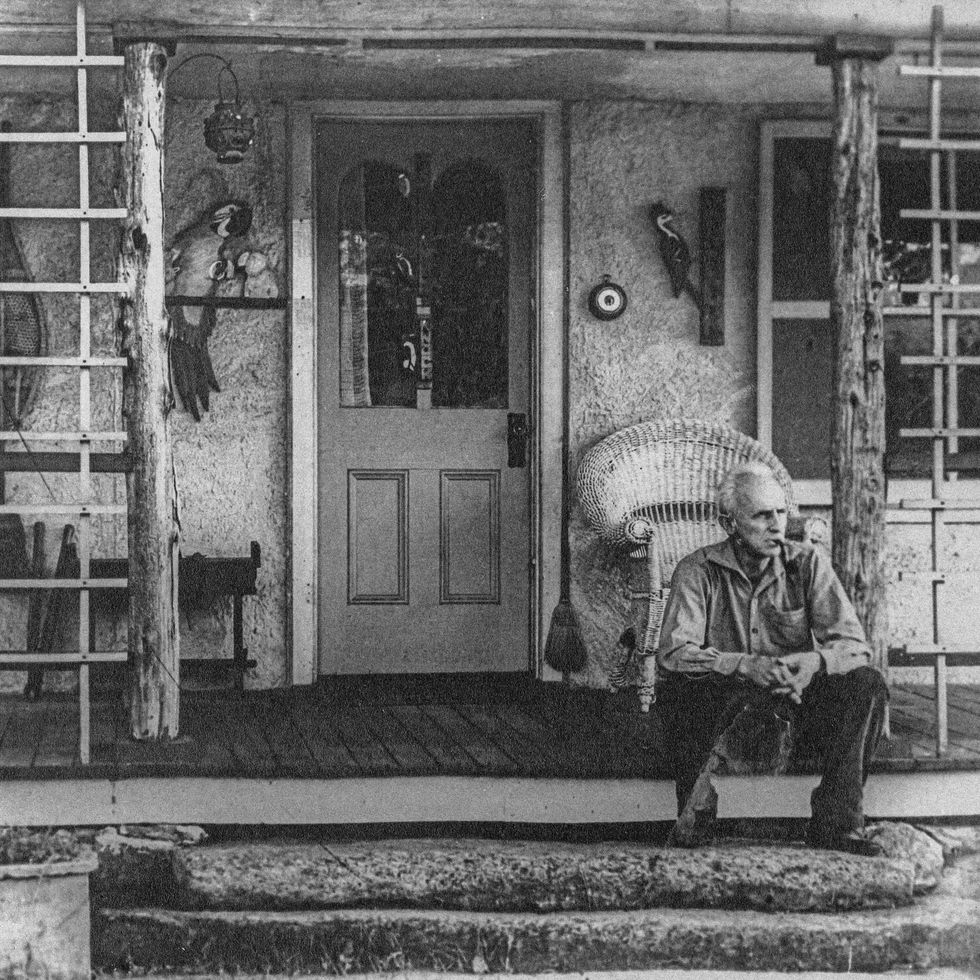
Founded in 2008 to preserve Brasher’s legacy and promote bird and habitat conservation through art, the Rex Brasher Association became an early point of connection for Hoffman, who composed and performed an original piece at the 2023 Rex Brasher Symposium just months after moving into Brasher’s former home. After many years in Brooklyn, Hoffman and his family had been looking for a change when they were shown the 116-acre property by association board member and architect Matthew Schnepf, who shared the history of the land and of Brasher himself.
“We’re the first renters outside of Rex’s family,” Hoffman said, explaining that the house is rented as part of an agreement to maintain the estate. Upon moving in, Hoffman dug deeper, purchasing the two-volume set of “Birds and Trees of North America” and immersing himself in Brasher’s world. Around the same time, and at the encouragement of composer, saxophonist and flutist Henry Threadgill, Hoffman debuted his first solo project at Tomeka Reid’s Chicago Jazz String Summit, planting the seed for the 13-track album that he then composed, recorded, mixed and mastered in Brasher’s home. The RBA (Rex Brasher Association) was equally supportive of the finished work, granting Hoffman permission to use Brasher’s artwork for the album, including the swallow-tailed kite painting that appears on the vinyl packaging. “You open up the record and the whole painting is right there,” said Hoffman.
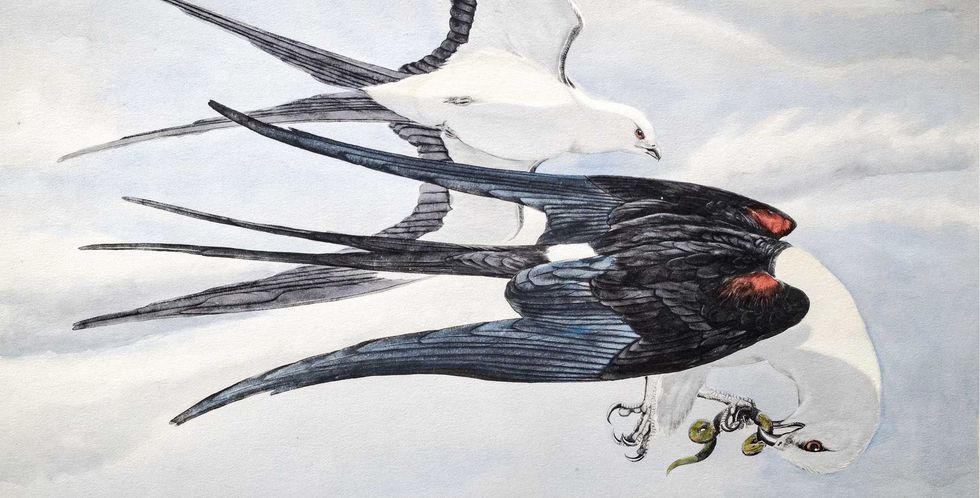
Though birds are central to the record’s spirit, Hoffman deliberately avoided literal birdsongs. Instead, the cello is layered into dense soundscapes that suggest rather than illustrate. “There are tracks with tons of layered stuff where I guess you could hear bird sounds if you wanted to,” he said. Brasher’s refusal to accept approximation — destroying paintings when feathers didn’t look right — mirrored Hoffman’s own instincts as a musician. Tracks were built, discarded, rebuilt. Nothing stayed unless it felt true.
For Hoffman, “Rex” became a kind of reckoning. Though Hoffman has begun noticing birds with new intensity, using the Merlin bird app to identify some 30 species on the grounds, he says Brasher’s acuity still feels out of reach. “Even with binoculars, I still can’t see the details he was seeing.”
The album will be released Jan. 16 on Out of Your Head Records. Composed for acoustic and electric cello, the record reflects the solitude and intensity that shaped both Brasher’s vision and Hoffman’s process. “This guy was working so hard,” said Hoffman of Brasher. “And it was like, ‘Alright, Chris, get it together. Make the solo record you’re afraid to make.’”
To listen and purchase the album, go to: https://christopherhoffman.bandcamp.com/album/rex
Thuan Nguyen and Britt Rovi are old friends and now business partners at the Zen Den.
A holistic healing center, the Zen Den, has opened at 58 Main St. in Winsted. Described as a revolutionary clinical wellness center, it offers classes and individual, couples, and family therapy focused on trauma and wellness. Its intention is to bring high-end holistic healing practices to the masses. As the founders say, “Make it reasonable, doable, and achievable.”
The space is warm, soothing, sunny and inviting. At a soft opening for family and friends on Dec. 5, the mood was mellow and joyous. Each arrival was greeted with a hug as children twirled around the room. Soft coral walls, small Buddhas, sage for burning, a central gong, green plants, pastel sound bells and soft music create a sense of calm. The center even has a healing dog!
Founders Britt Rovi, an LPC, and Thuan Nguyen are old friends who most recently worked together at Mountainside Treatment Center in Canaan. They bring extensive experience as therapeutic healers and as survivors of their own journeys from adversity to wellness.
“We believe healing happens in community — where you can feel connected, seen and loved,” they said. “So please help us spread the word about this cool, soulful, and uplifting new space — a hip, spiritual hangout for those who crave purpose, meaning and connection.”
The new clinical wellness membership center combines holistic treatments such as yoga, reiki, qi gong, sound baths, somatic therapy and trauma-informed care for mind, body and soul with clinical groups for stress management, grief and trauma.
Nguyen, who was born in Vietnam during the War, survived a harrowing escape with his family, later settling in Westchester and attended Vassar College and Cornell University. He became addicted to crystal meth and his family got him into rehab. He recalled his journey to sobriety:
“In recovery meetings, people gave me a language for my experience, words I never had access to before. They shared their stories with honesty and courage, creating a space safe enough for me to find my own. My journey continued through meditation, yoga, energy healing and various wellness practices that helped me return to myself. I learned that true healing is holistic — it touches mind, body, spirit and community.”
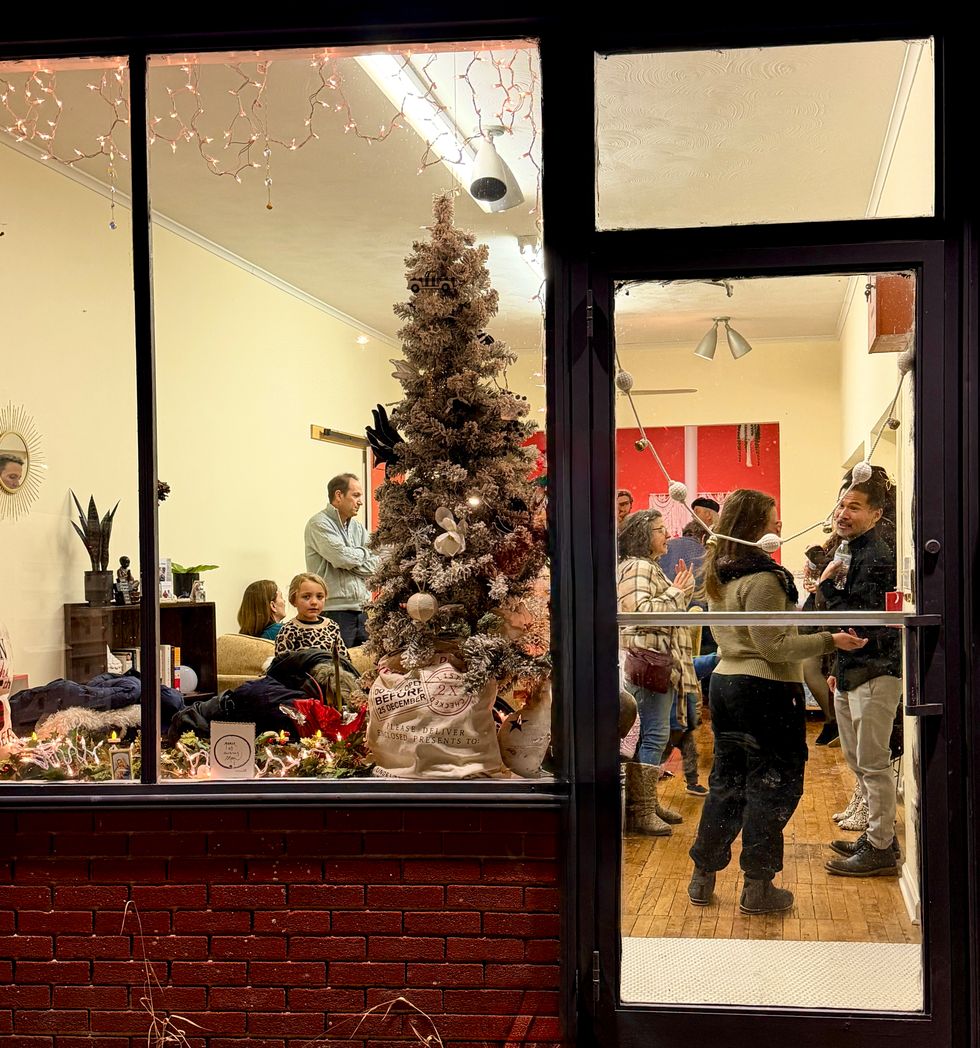
Nguyen has since worked at two nationally recognized inpatient treatment centers as a 12-step coach, spiritual advisor, wellness coordinator, manager and director. He is also a master teacher in Usui Reiki and certified in Karuna Reiki.
Rovi is a clinical life and relationship coach with a master's degree in clinical mental health counseling and a specialization in family therapy. During college, the sudden suicide of a dear friend plunged her into a self-destructive spiral. A spiritual awakening centered her, and she began her remarkable journey to wellness.
When asked about her dream for the center, she said, “Community more than anything. We live in a world where everything is sad, stressful and hard.We need connection and to not feel alone. I want to ignite that spark in humanity again from a small local vibe. I want to breathe hope back into the world.”
Rovi and Nguyen are grateful for the support of the Winchester Economic Development Commission, which helped them open their doors on Main Street near the town green. At noon on Dec. 27, there will be a ribbon-cutting ceremony with members of the commission, and the community is invited.
For more information and to become a member of the Zen Den community, visit: thezendencenter.com
Left, A cup of ilse’s fairly-sourced coffee in the new Great Barrington location. Right, Natalha Palhete, an orange wine from the Alentejo region of Portugal, was on the specials menu on Thursday, Dec. 18.
Fall brought two additions to the growing southern Berkshires café and bar scene with the opening of the lounge-like natural wine purveyor Half Rats in late August, followed by beloved North Canaan specialty roastery ilse coffee installing its second location on Railroad Street in mid-November.
Head up to Great Barrington this holiday season to caffeinate, then ingurgitate (in moderation) – just don’t forget to hydrate.
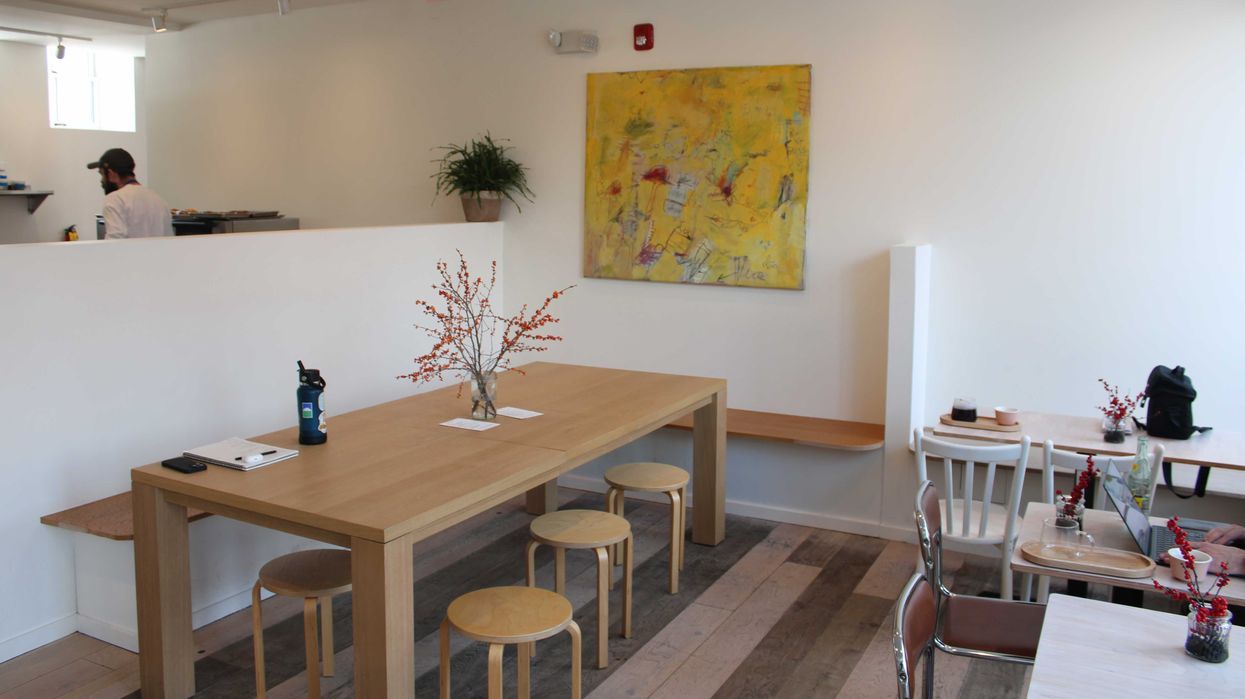
(47 Railroad Street, Great Barrington, Massachusetts). Hours: Thursday - Monday, 8 a.m. to 3 p.m.; Sunday open at 9 a.m.
Stylized lowercase, this sleek coffee brand does away with pretense and lets the brew speak for itself. Sourced ethically and with a focus on partnerships between producers, consumers and the roastery itself, a black coffee at ilse is served on a tidy tray in a clear glass mug, alongside a ceramic cup for the drinker to transfer the elixir into at their leisure. The whole set up feels emblematic of the transparency and collaboration at the core of the roastery’s ethos.
Situated in the airy space formerly occupied by Marjoram + Roux, the new coffeehouse builds on the concept inaugurated by ilse’s first public location in a converted auto body shop in North Canaan. Rebecca Grossman, who co-founded and co-owns the business with her fiancée, Lucas Smith, is local to the area, leading the couple to move roasting operations north from Stamford when they decided to expand from the wholesale production they had focused on the previous four years.

With the new shop, the brand moves even further into the food-and-beverage service game, aiming to build out a full breakfast and lunch menu as it ramps up operations on Railroad Street. Currently, the bites on offer are primarily provided by Canaan-based baker Pastries By Hanna, with the addition of one item produced in-house: a fluffy scone stuffed with cream and jam – Smith’s mother’s recipe; she’s English. In the coming months, the open kitchen that takes up about half of the café’s interior will roar to life as the team develops the culinary program.
Stylistically, the space follows the minimal, elegant example set by the North Canaan location, but lower ceilings, tighter quarters and a communal table that abuts the bustle of the above-mentioned open kitchen make for a decidedly cozier atmosphere. Tuck yourself into a window seat and sip a cup of steaming, ethically-sourced coffee while gazing down at the brick-lined streets beneath the hulking ridgeline of East Mountain, and you’ll find it easy to remember why you love the Berkshires.
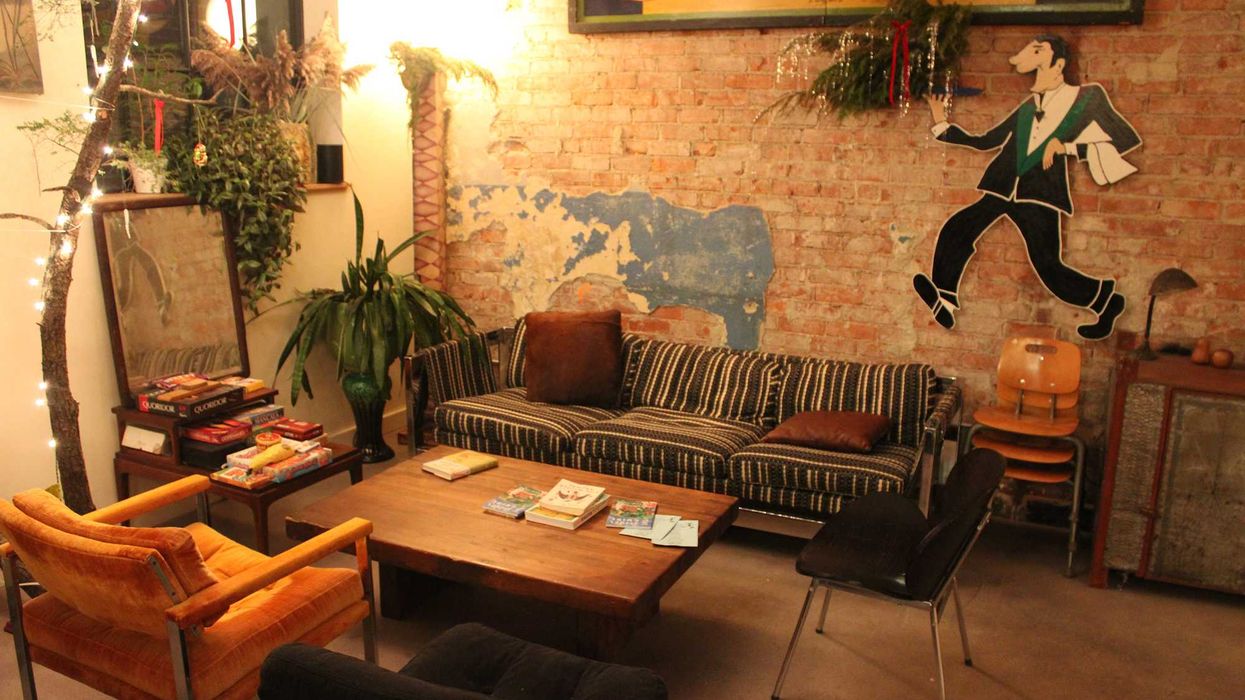
(343 Main Street, Great Barrington, Massachusetts). Hours: Wednesday and Sunday, 4 p.m. to 9 p.m.; Thursday – Saturday 4 p.m. to 10 p.m.
Natural wine and resurrected Victorian slang are unlikely partners in Abby Pendergist’s new downtown venture that happily marries modern tastes with classic appeal.
“Half Rats” references 19th-century parlance meaning slightly tipsy, or buzzed, which is exactly what guests are invited to become – responsibly, of course – as they swill Pendergist’s rotating ensemble of natural wines from around the world. The snobbery that sometimes hangs over wine-forward enterprises is nowhere to be found here, perhaps booted out by the semi-deranged rodents who decorate the menus, clearly half rats themselves. Instead, the vibe is decidedly relaxed, inviting drinkers to approach the wines with an open and playful attitude.
The space, designed and decorated by Pendergist with help from her boyfriend, Nick Speidel, indicates a well-practiced eye is behind the madness. Located within the tall brick walls of the 1924 Whalen & Kastner Garage, Pendergist has tastefully decked out the room with quirky paintings, a hemlock sapling adorned with string lights, rat-themed T-shirts and the taxidermized head of an antelope wearing an evergreen garland as a necklace. Memorabilia is all around – Pendergist has a background in selling antique clothes, including at a former brick and mortar on Railroad Street.

Amid the mayhem, there is a carefully-wrought logic to the space. Guests freely move from seats at the pounded steel bar to a comfortable lounge, where games and wine literature await, or simply peruse the walls as one might in a gallery. A massive communal table dominating the center of the room is highly modular in its function, hosting large parties of wine drinkers or pumpkin carving contests alike. Several window tables and high-tops offer couples seeking a quieter drink the opportunity to do so with some privacy.
Like everything else, the menu is eclectic and changeable. A core selection of Pendergist’s favorite bottles remain while others rotate, though no bottle is safe from being swapped out. In addition to the main lineup, special bottles are also on offer until they run out. On a recent Thursday, a chilled and unchilled red, both Austrian, graced the specials menu, joined by another red, this one Georgian, as well as a Portuguese orange and a white gleaned from the faraway lands of Maine.
A short, rotating list of craft beers, alongside cheaper standards ($4-$5), are also available, as well as non-alcoholic options such as Mexican coke and espresso. Simple but enticing bar snacks — including olives, a goat cheese plate and “Spanish skewers” of anchovy, olives and pepper — are also available for those who like a snack with their Syrah.
For those who want to bring the experience home, small souvenirs and knickknacks, including Christmas cards, are available for sale at the bar. A Syrah, and snack and a sticker it is, then.